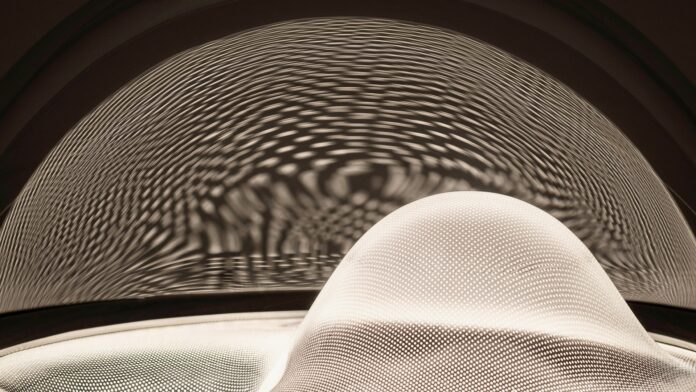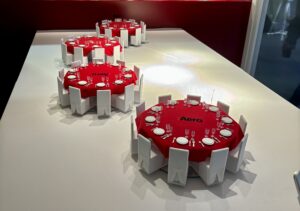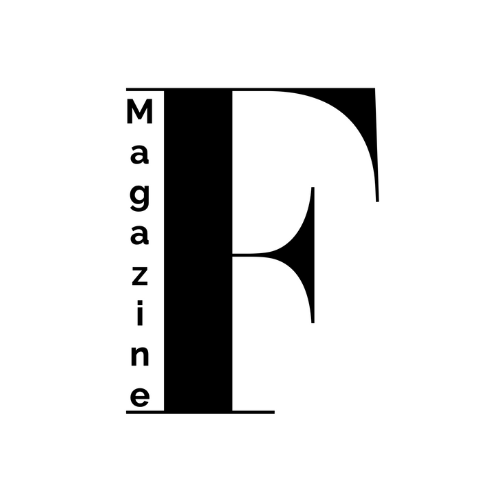La Light + Building 2024 a Francoforte si è recentemente conclusa, rappresentando una delle fiere dell’illuminazione più importanti e influenti a livello globale. La rivista Fairness Magazine ha cercato di approfondire le tendenze e le sfide che questo settore è destinato ad affrontare nei prossimi anni.
A tal fine, abbiamo intervistato Walter Valli, un architetto e talentuoso designer di illuminazione di origine italiana, che risiede a Barcellona da oltre un decennio
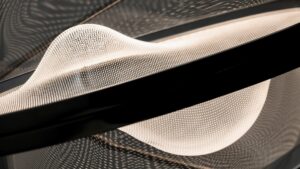
[Walter Valli proviene da Roma e si è laureato in Architettura presso la Facoltà di Architettura La Sapienza di Roma. Ha trascorso due anni studiando presso la Facoltà di Architettura dell’Università RWTH Aachen, in Germania. Nel 2005 si è trasferito a Barcellona per conseguire un master in Architettura Efimera presso l’Università Politecnica di Catalogna. Durante questo periodo, lavorando in vari studi di architettura, ha scoperto il mondo del design dell’illuminazione. Walter ha poi lavorato in rinomati studi internazionali di design dell’illuminazione, contribuendo a progetti in tutto il mondo. La sua passione per il design degli interni lo ha portato a frequentare corsi di specializzazione presso l’Università del Design di Milano in “New Entertainment Design” e “Bathroom Design”. Negli ultimi anni si è impegnato profondamente nel promuovere la cultura della luce, condividendo la sua esperienza attraverso conferenze nel programma di master in design dell’illuminazione presso l’Università Politecnica di Catalogna (Barcellona) e Elisava. Con il suo studio di design dell’illuminazione, realizza progetti in tutto il mondo, collaborando con altri designer per creare spazi ed esperienze affascinanti.]
Per saperne di più sull’architetto Walter Valli, visita il sito web ➡️ https://waltervalli.com/

-
Quali sono le tendenze e le novità più interessanti che hai scoperto durante l’ultima fiera Light and Building?
Inizierò con una breve panoramica per fornire contesto al lettore. La Light & Building di quest’anno ha segnato un ritorno al formato tradizionale dopo la pausa indotta dalla pandemia. La presenza di produttori noti e veterani ha conferito alla fiera un’atmosfera familiare assente durante l’edizione dell’anno precedente. Questo evento, il più grande in Europa nel settore dell’illuminazione, è rinomato a livello mondiale sia per l’illuminazione tecnica che decorativa, nonché per la presentazione di accessori, componenti e nuove tecnologie. Le aspettative erano quindi alte. L’impressione iniziale esplorando gli stand era quella di cercare significative innovazioni e sorprese. Anche se non vi sono state rivoluzioni epocali nel settore, sono state evidenziate ottimizzazioni e sviluppi dei sistemi di illuminazione esistenti. Prodotti meccanizzati e controllabili a distanza, adattabili a varie configurazioni di spazio, soprattutto nei settori del commercio al dettaglio e dell’ospitalità, sono stati presentati. Tuttavia, ciò che ha colpito positivamente è stata l’attenzione alla sostenibilità. Le discussioni ruotavano intorno alla riduzione degli sprechi, al rigoroso controllo del consumo e alla creazione di materiali ad alte prestazioni e compostabili. Si è posta una costante attenzione all’illuminazione orientata al benessere umano, animale e vegetale, nel rispetto dell’ambiente circostante. In conclusione, la fiera ha confermato la sua rilevanza, offrendo nuove prospettive e riaffermando l’importanza di un’illuminazione sostenibile e orientata al benessere.
-
Cosa pensi sia il futuro dell’illuminazione e come pensi che la tecnologia possa influenzare il settore?
Certamente, l’illuminazione sarà presto integrata con l’Intelligenza Artificiale (AI), non solo per quanto riguarda il design, ma anche per la gestione e la manutenzione dei dispositivi e dei sistemi di illuminazione. In un futuro prossimo, l’illuminazione sarà in grado di adattarsi non solo al nostro umore e alla nostra situazione, ma anche all’uso dello spazio, tenendo conto del passare del giorno e rispondendo alle nostre esigenze momentanee attraverso l’osservazione delle nostre espressioni, dei nostri gesti e ascoltando le nostre indicazioni verbali o comandi dati attraverso dispositivi intelligenti. Questa evoluzione è in corso da qualche tempo ma sarà ulteriormente ottimizzata grazie all’AI. Possiamo accogliere positivamente questa idea o preoccuparci per i cambiamenti che porta. Tuttavia, è inevitabile che anche i più scettici si adegueranno e accetteranno, almeno in parte, questa nuova rivoluzione tecnologica, compresa l’illuminazione.
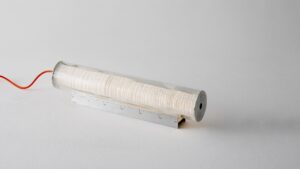
-
Quali sfide e opportunità presentano gli ultimi sviluppi tecnologici per i designer di illuminazione?
Dal mio punto di vista, alla fine della fiera, lascio con la sensazione che l’illuminazione stia già intraprendendo il cammino indicato nelle risposte precedenti. Si impegna attivamente nella lotta ai cambiamenti climatici, al controllo del consumo energetico, alla radiazione, all’inquinamento luminoso e alla promozione del riciclo dei materiali. Le nuove tecnologie si integrano con l’illuminazione per promuovere il nostro benessere mantenendo un saldo rispetto per la natura, comprese flora, fauna e cieli. I dispositivi di illuminazione sono realizzati con dimensioni sempre più ridotte, utilizzando meno materiali e favorendo quelli riciclati, riciclabili o compostabili, senza compromettere le prestazioni illuminotecniche.
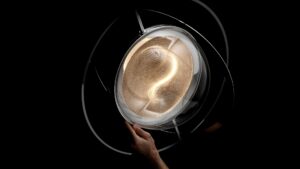
-
Quali sono i prodotti/lampade che ti hanno ispirato di più e che intendi includere nei tuoi futuri progetti di illuminazione?
Certamente, i sistemi di illuminazione con binari estremamente sottili, microproiettori e profili metallici o realizzati con nuovi materiali integrando strisce LED ad alte prestazioni e a basso consumo energetico. Riguardo all’illuminazione decorativa, sono rimasto impressionato dalle lampade realizzate con materiali ecologici, dalle forme sinuose e accattivanti con texture innovative. Queste creazioni, frutto della fusione tra creatività umana e intelligenza artificiale per ottimizzare il processo produttivo, hanno spesso utilizzato stampanti 3D per la loro realizzazione. Inoltre, sono rimasto affascinato dai prodotti di aziende consolidate nel settore, che combinano il lavoro dei designer con la ricerca scientifica e gli studi approfonditi sui fenomeni naturali. Queste creazioni riflettono un profondo dialogo tra arte e scienza, offrendo soluzioni innovative e di alta qualità.
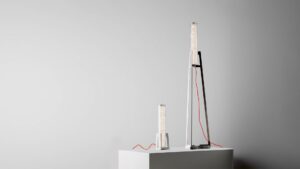
-
Per noi neofiti dell’illuminazione, puoi fornire un’indicazione più concreta di un apparecchio o di una marca?
Il marchio XAL ha introdotto il marchio IQ LUX, presentando una linea di prodotti realizzati con materiali organici e compostabili, con forme sinuose e texture accattivanti. Artemide ha attirato l’attenzione con un prodotto risultante dalla collaborazione tra lo studio di architettura Miralles/Tagliabue e l’astrofisica Ersilia Vaudo, dando vita alla lampada LUNE D’ACQUA ispirata ai satelliti d’acqua ghiacciati di Giove e Saturno. La serie CRIOSFERA, anch’essa concepita per Artemide dall’architetto e ricercatore Giulia Foscari, studiosa dell’Antartide, evoca strutture per il trapano dei ghiacciai antartici, con il corpo illuminante costituito da una stratificazione di vetro soffiato e riciclato con un nucleo ottico che evoca la stratificazione del ghiaccio polare. Per l’illuminazione tecnica, Stucchi ha presentato una nuova serie di binari sottili e relativi microapparecchi, mentre il marchio AERO ha sorpreso con un design minimalista e tecnologia avanzata, come la serie ATL di illuminazione motorizzata. OPPLED SDL ha ampliato lo spettro luminoso dei loro apparecchi per offrire illuminazione dinamica basata su HCL, riproducendo fedelmente la luce solare durante il giorno attraverso un sistema programmabile gestibile tramite PC.
Un ringraziamento speciale all’Architetto Walter Valli per il contributo
https://light-building.messefrankfurt.com/frankfurt/en.html
Ig – @fairness_mag
